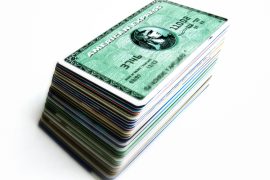Whether you’re buying gifts for under the tree or just taking advantage of holiday sales, December is one of those times when you might need some mental math skills. And while it can seem overwhelming to find out how much that 15%-off cashmere sweater will actually cost you, there are some easy ways to make quick work of these calculations and move on to the next item on your to-do list. (We’ll look at those on Friday.)
But first you need to answer one big question: Is an estimate good enough?
What’s the total cost?
Let’s say you’re picking up a few things for your Aunt Millie. She has given you a $20 bill and a list. You absolutely cannot exceed $20, and Aunt Millie is adamant that you get as much as you can for that amount. In this case, you may want to calculate everything down to the penny.
Or what if you’re purchasing holiday gifts for a family in need. You’ve set your budget — and you’re not going over it! Once you have everything in your cart, it could be reassuring to spend a moment or two finding the exact cost of your purchases.
(Here’s a cool hint, though. If you’re shopping online, these calculations are done for you. Just put what you want in your online shopping cart, and the totals will be appear — including shipping!)
Can you afford it?
But I would guess that most of us merely need to know if we can afford a purchase — or if what we’re interested in buying is too expensive. And that’s where estimation comes in handy.
Chandra’s family is HUGE. And after years of buying a Christmas gift for each of her nine siblings and their spouses and partners, she initiated the good old Secret Santa exchange. What a relief!
The process is simple. Over pumpkin pie after Thanksgiving dinner, Chandra’s mother brings out her best Sunday hat, which contains slips of paper — one for each of the 18 kids and their partners. Each person selects a name and buys a present for that person. The catch? No one can spend more than $50.
This year, Chandra is over the moon. She drew her sister-in-law’s name, and she knows exactly what to get her — a handmade purse from the local craft fair.
A week later, struggling through the crowd of candle-buying, carol-humming shoppers, Chandra finds exactly what she’s looking for: a cute little bag made of repurposed, 1940s dish towels. What a find!
She snatches up the bag, and pays $40 for it. But she’s got $10 left over. Should she find something to put inside?
Chandra starts looking for a little something more: there’s a handmade key fob for $2.50 or a little zipper pouch for $10. She starts feeling like Goldilocks — the pouch is too much and the key fob is not enough. She leaves knowing she can make up the difference while shopping elsewhere.
And she hits jackpot later that week. While picking up a few things at her local, independent bookstore, she spies a sweet little journal at the checkout line that would just fit into the purse. On sale for $6.50, she figures she has enough to pick up a rollerball pen to go with it.
Just right. (And notice — very little math!)
Is estimation mandatory?
So let’s say you are really into knowing your costs down to the penny. What if just having a general idea of what something costs is way too unnerving for you?
Pull out that calculator, sister or brother. There’s nothing wrong with finding the exact answer, if that’s what you need or want to do. Just do the rest of us shoppers a couple of favors — move to the side of the aisle while you do your computin’ and while you’re at it, don’t look down your nose at other’s estimations.
Are you an estimator or an exacting kind of person? If you estimate, how? If you like an exact answer, what tools do you use? Share your stories in the comments section.






Comments are closed.